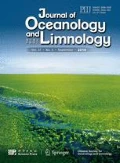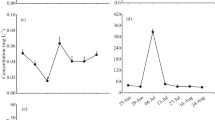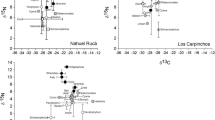Abstract
Allochthonous organic matter plays an important role in nutrient cycling and energy mobilization in freshwater ecosystems. However, the subsidies of this carbon source in floodplain ecosystems have not yet well understood. We used a Bayesian mixing model and stable isotopes (δ13C and δ15N) of primary food resources and dominant molluscs species, to estimate the relative importance of allochthonous carbon sources for consumers in a representative sub-lake of Poyang Lake during a prolonged dry season. Our study inferred that terrestrial-derived carbon from Carex spp. could be the primary contributor to snails and mussels in Dahuchi Lake. The mean percentage of allochthonous food resources accounted for 35%–50% of the C incorporated by these consumers. Seston was another important energy sources for benthic consumers. However, during the winter and low water-level period, benthic algae and submerged vegetation contributed less carbon to benthic consumers. Our data highlighted the importance of terrestrial organic carbon to benthic consumers in the wetlands of Poyang Lake during the prolonged dry period. Further, our results provided a perspective that linkages between terrestrial and aquatic ecosystems might be facilitated by wintering geese via their droppings.
Similar content being viewed by others
References
Bartels P, Cucherousset J, Gudasz C, Jansson M, Karlsson J, Persson L, Premke K, Rubach A, Steger K, Tranvik L J, Eklöv P. 2012. Terrestrial subsidies to lake food webs: an experimental approach. Oecologia, 168(3): 807–818.
Brett M T. 2014. Resource polygon geometry predicts Bayesian stable isotope mixing model bias. Marine Ecology Progress Series, 514: 1–12.
Carpenter S R, Cole J J, Pace M L, van de Bogert M, Bade D L, Bastviken D, Gille C M, Hodgson J R, Kitchell J F, Kritzberg E S. 2005. Ecosystem subsidies: terrestrial support of aquatic food webs from 13C addition to contrasting lakes. Ecology, 86: 2737–2750.
Cole J J, Carpenter S R, Pace M L, van de Bogert M C, Kitchell J L, Hodgson J R. 2006. Differential support of lake food webs by three types of terrestrial organic carbon. Ecology Letters, 9(5): 558–568.
Cremona F, Timm H, Agasild H, Tõnno I, Feldmann T, Jones R I, Nõges T. 2014. Benthic foodweb structure in a large shallow lake studied by stable isotope analysis. Freshwater Science, 33(3): 885–894.
Doi H. 2009. Spatial patterns of autochthonous and allochthonous resources in aquatic food webs. Population Ecology, 51(1): 57–64.
Fox A D, Cao L, Zhang Y, Barter M, Zhao M J, Meng F J, Wang S L. 2011. Declines in the tuber-feeding waterbird guild at Shengjin Lake National Nature Reserve, China-a barometer of submerged macrophyte collapse. Aquatic Conservation: Marine and Freshwater Ecosystems, 21(1): 82–91.
Jefferies R L. 2000. Allochthonous inputs: integrating population changes and food-web dynamics. Trends in Ecology & Evolution, 15(1): 19–22.
Jones R I, Grey J, Sleep D, Quarmby C. 1998. An assessment, using stable isotopes, of the importance of allochthonous organic carbon sources to the pelagic food web in Loch Ness. Proceedings of the Royal Society B: Biological Sciences, 265(1391): 105–111.
Kitchell J F, Schindler D E, Herwig B R, Post D M, Olson M H, Oldham M. 1999. Nutrient cycling at the landscape scale: the role of diel foraging migrations by geese at the Bosque del Apache National Wildlife Refuge, New Mexico. Limnology and Oceanography, 44: 828–836.
Liu X Q, Wang H Z, Liang X M. 2006. Food web of macroinvertebrate community in a Yangtze shallow lake: trophic basis and pathways. Hydrobiologia, 571(1): 283–295.
Liu X Q, Wang H Z. 2007. Food composition and dietary overlap of macro-invertebrates in a shallow eutrophic lake in China: spatial and temporal variations. Fundamental and Applied Limnology/Archiv für Hydrobiologie, 168(1): 71–82.
Liu Y J, Ouyang S, Wu X P. 2008. Distribution and status of freshwater bivalves in the Poyang Lake. Jiangxi Science, 26(2): 280–283, 299. (in Chinese with English abstract)
Luo H, Gao Y Y, Yu Y Z, Wu X D, Cao R, Yi W S, Wen S B, Hao N Z, Yang R X, Gao X, Mei Y, Guo Y J. 2010. Research of the relationship between birds and aquatic plants, transparency and water of Poyang Lake. Jiangxi Science, 28(4): 559–563. (in Chinese with English abstract)
Marchese M R, Saigo M, Zilli F L, Capello S, Devercelli M, Montalto L, Paporello G, Wantzen K M. 2014. Food webs of the Paraná River floodplain: assessing basal sources using stable carbon and nitrogen isotopes. Limnologica-Ecology and Management of Inland Waters, 46: 22–30.
Molina C I, Gibon F M, Oberdorff T, Dominguez E, Pinto J, Marín R, Roulet M. 2011. Macroinvertebrate food web structure in a floodplain lake of the Bolivian Amazon. Hydrobiologia, 663(1): 135–153.
Oliveira A C B, Soares M G M, Martinelli L A, Moreira M Z. 2006. Carbon sources of fish in an Amazonian floodplain lake. Aquatic Sciences, 68(2): 229–238.
Pace M L, Cole J J, Carpenter S R, Kitchell J F, Hodgson J R, Van de Bogert M C, Bade D L, Kritzberg E S, Bastviken D. 2004. Whole-lake carbon-13 additions reveal terrestrial support of aquatic food webs. Nature, 427(6971): 240–243.
Parnell A, Inger R, Bearhop S, Jackson A L. 2010. Source partitioning using stable isotopes: coping with too much variation. PLoS One, 5(3): e9672.
Peterson B J, Fry B. 1987. Stable isotopes in ecosystem studies. Annual Review of Ecology and Systematics, 18: 293–320.
Polis G A, Anderson W B, Holt R D. 1997. Toward an integration of landscape and food web ecology: the dynamics of spatially subsidized food webs. Annual Review of Ecology and Systematics, 28: 289–316.
Post D M. 2002. Using stable isotopes to estimate trophic position: models, methods, and assumptions. Ecology, 83(3): 703–718.
Scharnweber K, Syväranta J, Hilt S, Brauns M, Vanni M J, Brothers S, Köhler J, Knežević-Jarić J, Mehner T. 2014. Whole-lake experiments reveal the fate of terrestrial particulate organic carbon in benthic food webs of shallow lakes. Ecology, 95(6): 1496–1505.
Schumann R, Hammer A, Görs S, Schubert H. 2005. Winter and spring phytoplankton composition and production in a shallow eutrophic Baltic lagoon. Estuarine, Coastal and Shelf Science, 62(1–2): 169–181.
Sebastian-Gonzalez E, Navarro J, Sanchez-Zapata J A, Botella F, Delgado A. 2012. Water quality and avian inputs as sources of isotopic variability in aquatic macrophytes and macroinvertebrates. Journal of Limnology, 71(1): 191–199.
Sekercioglu C H. 2006. Increasing awareness of avian ecological function. Trends in Ecology & Evolution, 21(8): 464–471.
Solomon C T, Carpenter S R, Clayton M K, Cole J J, Coloso J J, Pace M L, Vander Zanden M J, Weidel B C. 2011. Terrestrial, benthic, and pelagic resource use in lakes: results from a three-isotope Bayesian mixing model. Ecology, 92(5): 1115–1125.
Turschak B A, Bunnell D, Czesny S, Höök T O, Janssen J, Warner D, Bootsma H A. 2014. Nearshore energy subsidies support Lake Michigan fishes and invertebrates following major changes in food web structure. Ecology, 95(5): 1243–1252.
Wang X, Zhang Y, Zhao M J, Cao L, Fox A D. 2013. The benefits of being big: effects of body size on energy budgets of three wintering goose species grazing Carex beds in the Yangtze River floodplain, China. Journal of Ornithology, 154(4): 1095–1103.
Wang Y Y, Yu X B, Li W H, Xu J, Chen Y W, Fan N. 2011. Potential influence of water level changes on energy flows in a lake food web. Chinese Science Bulletin, 56(26): 2794–2802.
Wantzen K M, de Arruda Machado F, Voss M, Boriss H, Junk W J. 2002. Seasonal isotopic shifts in fish of the Pantanal wetland, Brazil. Aquatic Sciences, 64(3): 239–251.
Wu Y H, Ji W T. 2002. Research on the Poyang Lake National Nature Reserve in Jiangxi Province. China Forestry Publishing House, Beijing. (in Chinese)
You H L, Xu L G, Liu G L, Wang X L, Wu Y M, Jiang J H. 2015. Effects of inter-annual water level fluctuations on vegetation evolution in typical wetlands of Poyang Lake, China. Wetlands, 35(5): 931–943.
Zeug S C, Winemiller K O. 2008. Evidence supporting the importance of terrestrial carbon in a large-river food web. Ecology, 89(6): 1733–1743.
Zhang J X, Lu J J. 1999. Feeding ecology of two wintering geese species at Poyang Lake, China. Journal of Freshwater Ecology, 14(4): 439–445.
Zhang L L, Yin J X, Jiang Y Z, Wang H. 2012. Relationship between the hydrological conditions and the distribution of vegetation communities within the Poyang Lake National Nature Reserve, China. Ecological Informatics, 11: 65–75.
Acknowledgement
We thank the Poyang Lake National Nature Reserve Agency for allowing us access to sites located in Dahuchi Lake and a permit to collect samples.
Author information
Authors and Affiliations
Corresponding author
Additional information
Supported by the National Natural Science Foundation of China (Nos. 41471088, 41301077)
Rights and permissions
About this article
Cite this article
Zhang, H., Yu, X., Wang, Y. et al. The importance of terrestrial carbon in supporting molluscs in the wetlands of Poyang Lake. Chin. J. Ocean. Limnol. 35, 825–832 (2017). https://doi.org/10.1007/s00343-017-6014-8
Received:
Accepted:
Published:
Issue Date:
DOI: https://doi.org/10.1007/s00343-017-6014-8




